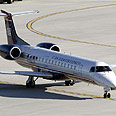
Tefillin layer's rabbi: Put on phylacteries after landing
Boy who just wanted to pray diverts US plane after laying tefillin on board, prompting emergency landing after crew suspected it was bomb. His religious leader suggests that in today's atmosphere one should pray on plane, lay tefillin afterwards
Some 30 minutes after taking off from New York's La Guardia Airport, US Airways flight 3079 to Kentucky made an emergency landing in Philadelphia when suspicions were aroused by a 17-year-old boy from White Plains, New York who was laying tefillin, which passengers and crew mistook for a bomb.
As it turns out, the passengers and crew were unfamiliar with the Jewish custom of donning phylacteries during morning prayers, and no one was willing to take any chances after a terrorist attack was thwarted on Christmas.
Lt. Frank Vanore, a spokesman for the Philadelphia police, explained in a conversation with the New York Times, that the flight crew “didn’t understand what it was,” he said, and the pilot “erred on the side of caution and decided to radio that in and to divert the flight.”
The boy’s grandmother, Frances Winchell, who was waiting for her grandson and his 13-year-old sister in Kentucky, said that she hopes that Americans learn a bit more about Jewish customs so that they are not afraid of them.
Rabbi Shmuel Greenberg of Young Israel of White Plains said that the boy and his family are part of his congregation. He said he knows the boy and that the young man was “a good boy, bright, intelligent, as docile as you can imagine.”
'Didn't think of the ramifications'
“He didn’t think of the ramifications, I guess,” Rabbi Greenberg said. “You can’t expect the whole world to know what this ritual is all about.”
He said men in his congregation recited morning prayers “if at all possible within four hours after sunrise.”
“Nobody would have assumed it would create panic,” he said, “but in today’s environment, I guess everything creates panic.”
Lt. Vanore said that the boy cooperated fully with the police who boarded the planed after it landed in Philadelphia and explained the Jewish ritual to them. Vanore said that the flight attendant had noticed the boy wrapping donning tefillin and asked him what he was doing. Here, too, the boy calmly explained that he was praying.
The flight attendant remained concerned about the tefillin, and called the cockpit to notify the pilot of what she saw.
She “described it as best as she’d seen it,” Lieutenant Vanore said, “and there was an item wrapped around his head, straps or wires.” “The straps did appear to be cables or wires to her,” he said. “To the naked eye looking at it, it looked like that. She said it had wires running from it and going up to his fingers. When they notified the pilot of that, he had to follow his protocol.
“When they see a passenger strapping yourself,” said Isaac Abraham, a Satmar who lives in Williamsburg. “You might as well strap yourself with hand grenades. They have no idea.”
“He probably just figured, ‘I have nothing else to do on the plane, I might as well use this time to pray,’ ” he added. “Other people read. They watch a movie. He figured, ‘Let me grab the time.’ But the obvious reality of it is that when we see people carrying explosive material in their shoes and their pants and I am the passenger next to him and see someone strapping, I would panic too.”
Rabbi Greenberg, the boy’s rabbi, had some advice for future flights.
“I would suggest, pray on the plane and put the tefillin on later on,” he said. “Pray, and fulfill the ritual later.”










